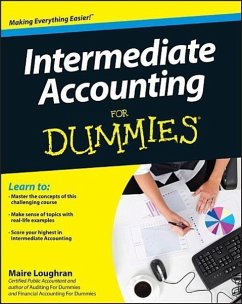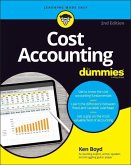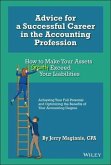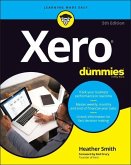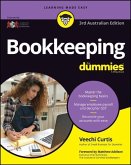Maire Loughran
Intermediate Accounting for Dummies
Maire Loughran
Intermediate Accounting for Dummies
- Broschiertes Buch
- Merkliste
- Auf die Merkliste
- Bewerten Bewerten
- Teilen
- Produkt teilen
- Produkterinnerung
- Produkterinnerung
The easy way to master an intermediate accounting course Intermediate accounting courses are required for students seeking bachelor's degrees in accounting and often for degrees in finance, business administration, and management.
Andere Kunden interessierten sich auch für
![Bookkeeping All-In-One for Dummies Bookkeeping All-In-One for Dummies]() Lita Epstein (University of Phoenix)Bookkeeping All-In-One for Dummies31,99 €
Lita Epstein (University of Phoenix)Bookkeeping All-In-One for Dummies31,99 €![Cost Accounting for Dummies Cost Accounting for Dummies]() Kenneth W. BoydCost Accounting for Dummies29,99 €
Kenneth W. BoydCost Accounting for Dummies29,99 €![International GAAP 2021 International GAAP 2021]() Ernst & Young LLPInternational GAAP 2021197,99 €
Ernst & Young LLPInternational GAAP 2021197,99 €![Advice for a Successful Career in the Accounting Profession Advice for a Successful Career in the Accounting Profession]() Jerry Maginnis (NJ Rowan University)Advice for a Successful Career in the Accounting Profession27,99 €
Jerry Maginnis (NJ Rowan University)Advice for a Successful Career in the Accounting Profession27,99 €![Xero for Dummies Xero for Dummies]() Heather SmithXero for Dummies28,99 €
Heather SmithXero for Dummies28,99 €![Accounting Disrupted Accounting Disrupted]() Al Bhimani (London School of Economics)Accounting Disrupted26,99 €
Al Bhimani (London School of Economics)Accounting Disrupted26,99 €![Bookkeeping for Dummies - Australia Bookkeeping for Dummies - Australia]() Veechi CurtisBookkeeping for Dummies - Australia27,99 €
Veechi CurtisBookkeeping for Dummies - Australia27,99 €-
-
-
The easy way to master an intermediate accounting course Intermediate accounting courses are required for students seeking bachelor's degrees in accounting and often for degrees in finance, business administration, and management.
Produktdetails
- Produktdetails
- Verlag: John Wiley & Sons Inc
- Seitenzahl: 384
- Erscheinungstermin: 19. April 2012
- Englisch
- Abmessung: 233mm x 189mm x 21mm
- Gewicht: 698g
- ISBN-13: 9781118176825
- ISBN-10: 1118176820
- Artikelnr.: 34447809
- Herstellerkennzeichnung
- Libri GmbH
- Europaallee 1
- 36244 Bad Hersfeld
- gpsr@libri.de
- Verlag: John Wiley & Sons Inc
- Seitenzahl: 384
- Erscheinungstermin: 19. April 2012
- Englisch
- Abmessung: 233mm x 189mm x 21mm
- Gewicht: 698g
- ISBN-13: 9781118176825
- ISBN-10: 1118176820
- Artikelnr.: 34447809
- Herstellerkennzeichnung
- Libri GmbH
- Europaallee 1
- 36244 Bad Hersfeld
- gpsr@libri.de
Maire Loughran is a certified public accountant who has prepared compilation, review, and audit reports for fifteen years. A member of the American Institute of Certified Public Accountants, she is a full adjunct professor who teaches graduate and undergraduate auditing and accounting classes.
Introduction 1
Part I: Introducing Financial Accounting and Standards 7
Chapter 1: Seeing the Big Picture of Financial Accounting 9
Chapter 2: Walking Through the Conceptual Framework of Financial Accounting
23
Chapter 3: Invaluable Valuation 43
Chapter 4: Reviewing the Accounting System 51
Part II: Preparing and Using Financial Statements 65
Chapter 5: Posting Income Statement Profit and Loss 67
Chapter 6: Reporting Assets and Claims: Keeping Your Balance (Sheet) 83
Chapter 7: Follow the Money! Studying Cash Flow 101
Chapter 8: Time Is Money: Looking at the Time Value of Money 115
Part III: Homing in on Current and Noncurrent Assets 127
Chapter 9: Assessing Cash and Receivables 129
Chapter 10: Inventory Cost Flow Assumptions 145
Chapter 11: Buying and Selling Property, Plant, and Equipment (PP&E) 167
Chapter 12: Recognizing Depreciation, Impairments, and Depletion 183
Chapter 13: Keeping Track of Other Noncurrent Assets 197
Part IV: Analyzing Debt and Equity 207
Chapter 14: Tracking Current Liabilities and Contingencies 209
Chapter 15: Planning for Long-Term Obligations 227
Chapter 16: Letting Owners Know Where They Stand: The Equity Section 241
Part V: Accounting for Advanced Intermediate Issues 257
Chapter 17: Accounting for Income Taxes 259
Chapter 18: Accounting for Leases 277
Chapter 19: Fessing Up: Correcting Errors
and Reporting Changes in Methods 295
Chapter 20: Is That You, Revenue? Revenue Recognition Concepts 313
Part VI: The Part of Tens 327
Chapter 21: Ten Common Notes to the Financial Statements 329
Chapter 22: Ten Ratios for Financial Statement Analysis 337
Index 343
Part I: Introducing Financial Accounting and Standards 7
Chapter 1: Seeing the Big Picture of Financial Accounting 9
Chapter 2: Walking Through the Conceptual Framework of Financial Accounting
23
Chapter 3: Invaluable Valuation 43
Chapter 4: Reviewing the Accounting System 51
Part II: Preparing and Using Financial Statements 65
Chapter 5: Posting Income Statement Profit and Loss 67
Chapter 6: Reporting Assets and Claims: Keeping Your Balance (Sheet) 83
Chapter 7: Follow the Money! Studying Cash Flow 101
Chapter 8: Time Is Money: Looking at the Time Value of Money 115
Part III: Homing in on Current and Noncurrent Assets 127
Chapter 9: Assessing Cash and Receivables 129
Chapter 10: Inventory Cost Flow Assumptions 145
Chapter 11: Buying and Selling Property, Plant, and Equipment (PP&E) 167
Chapter 12: Recognizing Depreciation, Impairments, and Depletion 183
Chapter 13: Keeping Track of Other Noncurrent Assets 197
Part IV: Analyzing Debt and Equity 207
Chapter 14: Tracking Current Liabilities and Contingencies 209
Chapter 15: Planning for Long-Term Obligations 227
Chapter 16: Letting Owners Know Where They Stand: The Equity Section 241
Part V: Accounting for Advanced Intermediate Issues 257
Chapter 17: Accounting for Income Taxes 259
Chapter 18: Accounting for Leases 277
Chapter 19: Fessing Up: Correcting Errors
and Reporting Changes in Methods 295
Chapter 20: Is That You, Revenue? Revenue Recognition Concepts 313
Part VI: The Part of Tens 327
Chapter 21: Ten Common Notes to the Financial Statements 329
Chapter 22: Ten Ratios for Financial Statement Analysis 337
Index 343
Introduction 1
Part I: Introducing Financial Accounting and Standards 7
Chapter 1: Seeing the Big Picture of Financial Accounting 9
Chapter 2: Walking Through the Conceptual Framework of Financial Accounting
23
Chapter 3: Invaluable Valuation 43
Chapter 4: Reviewing the Accounting System 51
Part II: Preparing and Using Financial Statements 65
Chapter 5: Posting Income Statement Profit and Loss 67
Chapter 6: Reporting Assets and Claims: Keeping Your Balance (Sheet) 83
Chapter 7: Follow the Money! Studying Cash Flow 101
Chapter 8: Time Is Money: Looking at the Time Value of Money 115
Part III: Homing in on Current and Noncurrent Assets 127
Chapter 9: Assessing Cash and Receivables 129
Chapter 10: Inventory Cost Flow Assumptions 145
Chapter 11: Buying and Selling Property, Plant, and Equipment (PP&E) 167
Chapter 12: Recognizing Depreciation, Impairments, and Depletion 183
Chapter 13: Keeping Track of Other Noncurrent Assets 197
Part IV: Analyzing Debt and Equity 207
Chapter 14: Tracking Current Liabilities and Contingencies 209
Chapter 15: Planning for Long-Term Obligations 227
Chapter 16: Letting Owners Know Where They Stand: The Equity Section 241
Part V: Accounting for Advanced Intermediate Issues 257
Chapter 17: Accounting for Income Taxes 259
Chapter 18: Accounting for Leases 277
Chapter 19: Fessing Up: Correcting Errors
and Reporting Changes in Methods 295
Chapter 20: Is That You, Revenue? Revenue Recognition Concepts 313
Part VI: The Part of Tens 327
Chapter 21: Ten Common Notes to the Financial Statements 329
Chapter 22: Ten Ratios for Financial Statement Analysis 337
Index 343
Part I: Introducing Financial Accounting and Standards 7
Chapter 1: Seeing the Big Picture of Financial Accounting 9
Chapter 2: Walking Through the Conceptual Framework of Financial Accounting
23
Chapter 3: Invaluable Valuation 43
Chapter 4: Reviewing the Accounting System 51
Part II: Preparing and Using Financial Statements 65
Chapter 5: Posting Income Statement Profit and Loss 67
Chapter 6: Reporting Assets and Claims: Keeping Your Balance (Sheet) 83
Chapter 7: Follow the Money! Studying Cash Flow 101
Chapter 8: Time Is Money: Looking at the Time Value of Money 115
Part III: Homing in on Current and Noncurrent Assets 127
Chapter 9: Assessing Cash and Receivables 129
Chapter 10: Inventory Cost Flow Assumptions 145
Chapter 11: Buying and Selling Property, Plant, and Equipment (PP&E) 167
Chapter 12: Recognizing Depreciation, Impairments, and Depletion 183
Chapter 13: Keeping Track of Other Noncurrent Assets 197
Part IV: Analyzing Debt and Equity 207
Chapter 14: Tracking Current Liabilities and Contingencies 209
Chapter 15: Planning for Long-Term Obligations 227
Chapter 16: Letting Owners Know Where They Stand: The Equity Section 241
Part V: Accounting for Advanced Intermediate Issues 257
Chapter 17: Accounting for Income Taxes 259
Chapter 18: Accounting for Leases 277
Chapter 19: Fessing Up: Correcting Errors
and Reporting Changes in Methods 295
Chapter 20: Is That You, Revenue? Revenue Recognition Concepts 313
Part VI: The Part of Tens 327
Chapter 21: Ten Common Notes to the Financial Statements 329
Chapter 22: Ten Ratios for Financial Statement Analysis 337
Index 343

